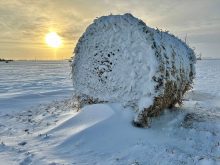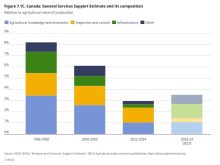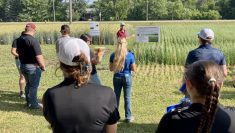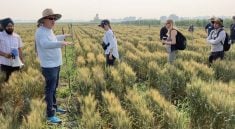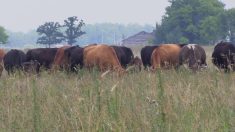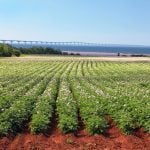This is going to be the year for cagey planning, according to Manitoba agronomists Wendy Kostur of Gilbert Plains and Jason Voogt of Carman.
The two big factors are last year’s drought, which has left moisture levels low, combined with this year’s input costs, they told the Manitoba Agronomist Conference earlier this winter.
“This is a huge year-over-year fertilizer cost we’re facing so it’s best to focus on putting nutrients right where they need to be,” Kostur said. “Our advice is make a great plan, and then have backup plans and be ready to pivot.”
Read Also

The sneak peek of Manitoba Ag Days 2026
Canada’s largest indoor farm show, Manitoba Ag Days, returns to Brandon’s Keystone Centre Jan. 20-22, 2026. Here’s what to expect this year.
Last year’s drought left a lot of fields dry and stunted and this has had its odd benefit, there was a fair amount of residual nitrogen in some places. Another factor was the late-August rains in some places that kick-started secondary growth bringing a lot of volunteers to bloom late in the season.
“And so what do we do with this?” Voogt asked, showing a slide with regrowth. “Are we going to spray it out or are we going to leave it? At this point in late August, even with some rains, we were still very much in a drought situation. Our subsoil was still depleted.
Growers could do one of two things. They could let the volunteers grow into the fall so the extra plant mass could catch more snow during the upcoming winter and collect more potential moisture for the spring.
Or they could terminate them, conserve what moisture was there and keep leftover nutrients in the ground to use in 2022. Kostur told of one of her farmer clients with a field of barley silaged off near the end of July.
“And then it had epic regrowth,” she said. “The farmer wanted to terminate it but I wanted to wait for more cleavers to come and it turned out he was right and I was wrong because, in the end, there were 40 pounds of nitrogen less than other fields nearby.”
“It’s important to understand that those nutrients are not lost in that volunteer regrowth but they’re going to need time, warm soil temperatures and moisture to recycle nutrients back into a plant-available form,” Voogt added. “When you look back at that, maybe nobody was actually wrong in their decisions but when you look at how much water or how much nitrogen or nutrients were used in this regrowth, it’s considerable.”
On the moisture front, there is one bit of good news for next year. The first major snowstorm dumped a fairly wet snow on unfrozen ground so the dry soil got its first dose of seepage late in the season. That has to be good for next spring.
On the nitrogen front, Kostur said the No. 1 question she got last fall was, “How much N do you think I have left?”
“And there was no standard answer,” she said. “Every farm, every field and every part of the field was different so, this year being so dry, there was no such thing as a good prediction. Our growers needed to know if they had high enough residual nitrogen to grow peas and then they wanted to know, is it a better idea to seed those fields with high residual N to wheat or canola to get the best use of it?”
She said it’s important to take a two-depth soil sample to know exactly where the residual nitrogen is. It could all be sitting eight to 10 inches deep which is not too far for roots to access nitrogen and sulphur. Voogt said growers should take the amount of residual N into consideration when they plan their rotations as well.
“In our area where we have a lot of soybeans and peas getting into more rotations and that may limit where you can put pulses based on the high amounts of nitrogen,” he said. “You might get away with it but in a lot of cases, with 180 pounds residual N, are soybeans or peas the right crop to utilize that N? You’re better off putting something in there that’s going to utilize it and, if we do run into issues of high losses in spring or seeing higher yield potential developing, then we can always go back in and top-dress if you have to.”
The next consideration is phosphorus and this one is a little trickier. Kostur says you need to know what your levels are and, are they optimal? Should you try to build your soil P or should you cut back because of the prices and go into a maintain program rather than a build program?
“For phosphate we really need to know where we’re sitting and every field is different so you can’t just sample three fields and think that will help you make the best decision for your whole farm,” she said. “We mine our background P too much and we’re going to be in trouble long term.”
She recommends zone sampling because it gives better information than a composite sample. A zone test represents three acres as opposed to a composite sample of five acres so it yields more useful information.
“This year, the strategy we’re supporting is to go with a maintain program rather than a build program,” she said. “We look at the guys who have phosphate levels of 12 to 28 parts per million and say you can back off a little bit this year but you have to remember, if you’re cutting your rates back you still want to use starter P.”
She recommends at least 15 pounds in the seed row for both cereals and canola.
“And we ask our guys to please, please, please promise us, the next time phosphate goes down in price that they’ll try to find some way to bump their levels up again.”
Voogt says a large part of that comes back to the field history when we look at more and more soybeans getting into our rotations. You can see a deficit over a four-year rotation because soybeans respond better to soil P rather than fertilizer P. We need to have the optimal levels there to feed them.
“What we’ve done over the last number of years is that build strategy utilizing pre-plant banding, fall banding and especially mid-rows and broadcasting in the spring if it makes sense,” he said. “What we need is a soil test history where we can verify the trends from those fields and use that to plan for 2022, then encourage growers to continue soil testing. It’s the most inexpensive investment they can look at to get this kind of information to help them make better fertilizer decisions.”



